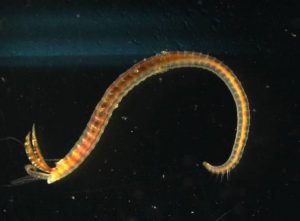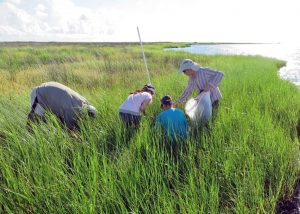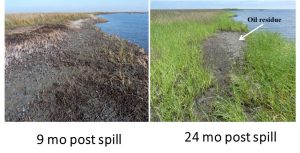Study Identifies Positive Influencers on Marsh Infauna Recovery after Oiling
– JANUARY 24, 2019
Scientists completed a regionally comprehensive analysis of impacts and recovery from Deepwater Horizon oiling in Louisiana’s Barataria Bay sediment-dwelling infaunal community (microalgae and small multi-cellular animals). The recovery of infauna was linked to the recovery of foundation plant species, sediment quality, and benthic microalgae. The regrowth of aboveground plant biomass, especially Spartina alterniflora (smooth cordgrass) and benthic algal biomass, was most important to initial infauna recovery. However, soil quality was the most important factor in longer-term recovery for infauna in marshes that suffered extensive plant mortality from oiling.
The researchers published their findings in Estuaries and Coasts (2019, 42: 204-217) What promotes the recovery of saltmarsh infauna after oil spills?
Sediment-dwelling plants and small animals form the base of wetland food webs and are critical for productive fish and shellfish communities. If these species recover at a slow pace following times of environmental stress, recovery at higher trophic levels will also be slowed. In the case of oil spills, initial impacts come primarily from the chemical composition and initial intensity of oiling. However, continued exposure to petroleum hydrocarbons can be influenced by soil structure, organic carbon content, oil burial, and rates of degradation and desorption that change over time. Oiling also degrades the soil’s environmental quality by affecting its physical, geochemical, and biological properties such as shading, oxygen supply, microbial transformations, and belowground plant structure.
“The plant community in northern Barataria Bay suffered almost complete mortality on saltmarsh shorelines that received the heaviest oiling after the Deepwater Horizon oil spill,” explained study author John Fleeger. “The goal of our research has been to quantify initial effects as well as the recovery of vascular plants, sediment-dwelling algae, and the invertebrates that populate these sediments. We also want to know which environmental factors aid or conversely slow recovery so we can improve methods to mitigate future spills.”
The team analyzed soil core samples collected shortly after the spill (beginning 18 months after the spill) and every six months afterwards (up to 6.5 years) for total petroleum hydrocarbon concentrations, live aboveground biomass of Spartina and Juncus, dead aboveground plant biomass, live belowground biomass, soil pH, soil bulk density, and microalgae biomass. Using a multi-variate approach, they identified the factors most important to recovery of the sediment-dwelling community.
“We found strong initial mortality and diminished ecosystem function on oiled shorelines,” explained Fleeger. “Many organisms began to recover within 2-3 years after the spill, but some did not recover as quickly as others, and recovery of the plant and animal community as a whole was incomplete after 6.5 years. This rate of recovery suggests that it will be more than a decade before the food-web base returns to pre-spill conditions.”
Different mechanisms associated with Spartina and benthic microalgae recovery likely contributed to the initial recovery of infauna. Spartina enhances infauna recovery as it slows water flow, which adds oxygen and particulate organic matter to the soil, enhances food resources and increases soil stability and shelter. Benthic microalgae serve as a food resource for many estuarine infauna and epifauna. However, long-term recovery of belowground plant structure lagged, which contributed to reduced soil quality and an associated slow recovery of some sediment-dwelling animals.
“Our research clearly indicates that improving plant growth after an oil spill enhances ecosystem recovery,” said Fleeger, “It is possible to plant Spartina in soil made bare by oiling, and the presence of aboveground structure should enhance the initial return of sediment-dwelling algae and animals. However, it will also be important to long-term recovery to find ways to facilitate the growth of plant belowground structure to improve soil quality.”
The study authors are Fleeger J. W., Riggio, M.R., Mendelssohn, I.A., Lin, Q., Deis, D.R., Johnson, D.S., Carman, K.R., Graham, S.A., Zengel, S.A., and Hou, A.
Data are publicly available through the Gulf of Mexico Research Initiative Information and Data Cooperative (GRIIDC) at doi:10.7266/N7DN430F, doi:10.7266/N7J9649F, and doi:10.7266/N7P26W1S.
By Nilde Maggie Dannreuther and Stephanie Ellis. Contact maggied@ngi.msstate.edu with questions or comments.
************
This research was made possible in part by a grant from the Gulf of Mexico Research Initiative (GoMRI) to Louisiana State University, Atkins North America, Inc., the Virginia Institute of Marine Science, and Nicholls State University for their projects Long-Term Impact, Recovery and Resilience: Wetland plant-microbial-benthic ecosystem responses to the Deepwater Horizon oil spill and mitigation strategies promoting sustainability and Meta-analytic synthesis of long-term wetland impacts, recovery, and resilience following the Deepwater Horizon oil spill.
The Gulf of Mexico Research Initiative (GoMRI) is a 10-year independent research program established to study the effect, and the potential associated impact, of hydrocarbon releases on the environment and public health, as well as to develop improved spill mitigation, oil detection, characterization and remediation technologies. An independent and academic 20-member Research Board makes the funding and research direction decisions to ensure the intellectual quality, effectiveness and academic independence of the GoMRI research. All research data, findings and publications will be made publicly available. The program was established through a $500 million financial commitment from BP. For more information, visit https://gulfresearchinitiative.org/.
© Copyright 2010-2019 Gulf of Mexico Research Initiative (GoMRI) – All Rights Reserved. Redistribution is encouraged with acknowledgement to the Gulf of Mexico Research Initiative (GoMRI). Please credit images and/or videos as done in each article. Questions? Contact web-content editor Nilde “Maggie” Dannreuther, Northern Gulf Institute, Mississippi State University (maggied@ngi.msstate.edu).








